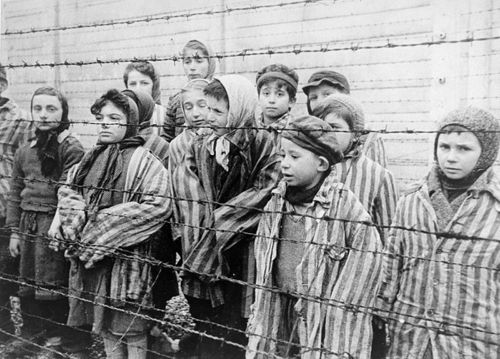Difference between revisions of "Category:Holocaust Children Studies--1990s"
Jump to navigation
Jump to search
(→1991) |
|||
| (3 intermediate revisions by the same user not shown) | |||
| Line 63: | Line 63: | ||
|} | |} | ||
==== | ==== 1995 ==== | ||
* Le mémorial des enfants juifs déportés de France (French children of the Holocaust / 1995, 1996 | |||
----- | |||
[[ | [[Category:Holocaust Children Studies| ]] | ||
Latest revision as of 16:38, 22 March 2022
|
|
Holocaust Children Studies : 2020s -- 2010s -- 2000s -- 1990s -- 1980s -- 1970s -- 1960s -- 1950s -- 1940s -- 1930s -- Home General : 2020s -- 2010s -- 2000s -- 1990s -- 1980s -- 1970s -- 1960s -- 1950s -- 1940s -- 1930s -- 1920s -- 1910s -- 1900s -- 1850s -- 1800s -- 1700s -- 1600s -- 1500s -- 1450s -- Medieval -- Home
|
1995
- Le mémorial des enfants juifs déportés de France (French children of the Holocaust / 1995, 1996
Subcategories
This category has only the following subcategory.
Media in category "Holocaust Children Studies--1990s"
The following 82 files are in this category, out of 82 total.
- 1990 Holland (film).jpg 332 × 475; 39 KB
- 1990 Lagnado.jpg 322 × 499; 38 KB
- 1990 Perel.jpg 324 × 499; 25 KB
- 1990 Wajda (film).jpg 208 × 300; 31 KB
- 1991 Brown.jpg 1,424 × 1,808; 525 KB
- 1991 Durlacher nl.jpg 120 × 200; 6 KB
- 1991 Dwork.jpg 339 × 499; 36 KB
- 1991 Gilbert.jpg 325 × 499; 31 KB
- 1991 Muller.jpg 351 × 499; 29 KB
- 1991 Urman.jpg 324 × 499; 27 KB
- 1992 Drucker.jpg 333 × 499; 38 KB
- 1992 Kertész.jpg 325 × 500; 33 KB
- 1992 Lindwer.jpg 318 × 499; 27 KB
- 1992 Van Wanegen film.png 252 × 396; 214 KB
- 1993 Faenza film.jpg 262 × 379; 23 KB
- 1993 Marks.jpg 322 × 499; 31 KB
- 1993 Matas.jpg 400 × 608; 81 KB
- 1993 Oberski it.jpg 201 × 339; 9 KB
- 1993 Pacifici.jpg 201 × 306; 6 KB
- 1993 Rubin.jpg 350 × 499; 24 KB
- 1993 Toll.jpg 322 × 499; 40 KB
- 1993 Valent.jpg 324 × 499; 30 KB
- 1994 Birenbaum en.jpg 333 × 499; 26 KB
- 1994 Kestenberg.jpg 314 × 499; 18 KB
- 1994 Kraus.jpg 321 × 499; 21 KB
- 1994 Levi.jpg 333 × 500; 30 KB
- 1994 Lukas.jpg 333 × 499; 40 KB
- 1994 Miller.jpg 339 × 499; 24 KB
- 1994 Rabinovici.jpg 327 × 499; 38 KB
- 1994 Rosenberg.jpg 310 × 474; 31 KB
- 1994 Stein.jpg 296 × 474; 23 KB
- 1994 Treves.jpg 201 × 293; 4 KB
- 1995 Akavia.jpg 318 × 499; 23 KB
- 1995 Blair doc.jpg 580 × 859; 100 KB
- 1995 Blend.jpg 400 × 625; 34 KB
- 1995 Boas.jpg 334 × 499; 30 KB
- 1995 Bricarelli.jpg 204 × 300; 5 KB
- 1995 Frank en.jpg 400 × 661; 218 KB
- 1995 Graver (book).jpg 400 × 630; 32 KB
- 1995 Lee.jpg 336 × 474; 19 KB
- 1995 Levi.jpg 187 × 266; 5 KB
- 1995 Machlin.jpg 310 × 475; 39 KB
- 1995 Nagaoka (film).jpg 267 × 372; 13 KB
- 1995 Pagnotti.jpg 327 × 499; 31 KB
- 1995 Starkopf.jpg 332 × 499; 22 KB
- 1995 Zargani.jpg 319 × 499; 27 KB
- 1996 Bennett (play).jpg 300 × 436; 52 KB
- 1996 David 2.jpg 177 × 250; 9 KB
- 1996 Hochberg - Grüss en.jpg 326 × 499; 39 KB
- 1996 Kestenberg.jpg 429 × 640; 77 KB
- 1996 Lazan.jpg 326 × 499; 23 KB
- 1996 Werber.jpg 308 × 499; 41 KB
- 1997 Bender (film).jpg 1,000 × 1,855; 156 KB
- 1997 Benigni (film).jpg 262 × 379; 28 KB
- 1997 Brenner.jpg 400 × 599; 126 KB
- 1997 Gold.jpg 400 × 586; 34 KB
- 1997 Kragh-Jacobsen film.jpg 1,000 × 1,400; 129 KB
- 1997 Maarsen en.jpg 1,920 × 2,560; 266 KB
- 1997 Melnick (book).jpg 400 × 648; 22 KB
- 1997 Minac (film).jpg 334 × 475; 26 KB
- 1997 Rimini.jpg 336 × 499; 17 KB
- 1997b Bitton-Jackson.jpg 298 × 500; 40 KB
- 1997b Winter.jpg 311 × 499; 24 KB
- 1998 Durlacher en.jpg 292 × 499; 26 KB
- 1998 Immell (ed).jpg 312 × 500; 33 KB
- 1998 Kestenberg.jpg 314 × 499; 19 KB
- 1998 Muller de.jpg 312 × 500; 29 KB
- 1998 Müller (book).jpg 334 × 499; 24 KB
- 1998 Müller en (book).jpg 400 × 606; 30 KB
- 1998 Nieuwsma.jpg 375 × 499; 28 KB
- 1998 Rabinovici en.jpg 323 × 499; 37 KB
- 1998 Rittner (ed).jpg 346 × 499; 15 KB
- 1999 Bloom (ed).jpg 226 × 350; 14 KB
- 1999 Fleischmann.jpg 338 × 499; 15 KB
- 1999 Fox.jpg 410 × 500; 36 KB
- 1999 Harris.jpg 324 × 499; 21 KB
- 1999 Justman (doc).jpg 1,000 × 1,333; 129 KB
- 1999 Kertész it.jpg 324 × 499; 25 KB
- 1999 Kustanowitz.jpg 371 × 499; 24 KB
- 1999 Minsky.jpg 332 × 499; 30 KB
- 1999 Segre (book).jpg 699 × 1,174; 149 KB
- 1999 Varon.jpg 328 × 499; 20 KB




















































































